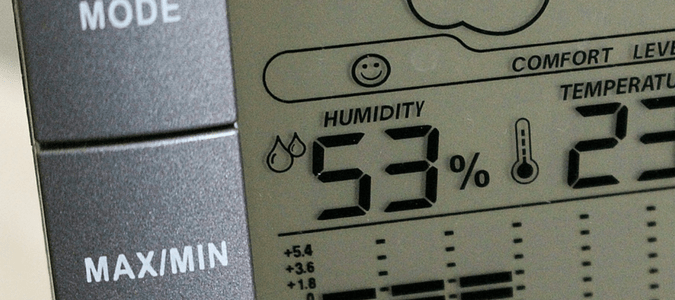
One surprising thing for homeowners can be the presence of humidity or moisture in a home and what that moisture brings along with it. Humidity is simply the amount of moisture in the air, and most people are comfortable with a relative humidity level of about 45% at home. When humidity is high, the air seems hotter and heavier. Excessive humidity may encourage mold growth, which can lead to bad smells, structural damage and health problems. House mold cannot exist without a source of moisture.
How to Get Rid of Moisture in Your Home
Wondering why it’s feeling humid in your home, and what you can do about it? Learn both how to make your indoor spaces more pleasant and how to prevent humidity in your home in the future below.
Telltale Signs of Moisture and Humidity
Inside your home, you might feel a change in humidity in a few ways: as dampness on your skin, foggy windows, mildew or a musty odor. Over time, there could be damp spots, mold or rotting wood that could be harming your home from too much moisture inside.
What Causes High Humidity in a House?
Bathing, showering, laundering and the use of all types of appliances may cause humidity and moisture to build up in a home. Even cooking gets into the mix when oven and stove-top cooking produce more moisture.
Preventative Measures
Is your home feeling comfortable at the moment, and want to make sure it stays that way? Place your houseplants outside temporarily or move them into one room that tends to be dry. Since plants release moisture vapor into the air, home humidity levels can be significant if you have a large number of plants or a few that tend to get over-watered. Likewise, freshly-cut firewood may contain large amounts of water that will evaporate when stored indoors. Firewood is best stored outside.
If you want to go the extra mile, head to the exterior of your home. Keeping your home’s downspouts and gutters clean and free of debris can impact your home environment. Adjust all downspouts so that they carry water farther away from the house to prevent water from pooling at and around the foundation, which can impact indoor air quality.
Rid Your Home of Moisture
The fastest and easiest way to bring the humidity down and reduce the chance of moisture damage is to ventilate. Here are the main spots in your home to start:
- Focus on the wet locations first, such as the kitchen, bathroom(s), laundry room and basement (if you have one).
- Not only do showering and cooking create moisture but also your washing machine and dryer use affect the amount of moisture found in the home.
If you do not have exhaust fans or a ventilation system, you can crack a window for a few minutes regularly to dry the air out. This can be especially useful in the bathroom, a room which tends to hang onto additional moisture for longer periods.
Consider using a dehumidifier if you live in an older, less-ventilated home. Dehumidifiers work best with closed doors and windows and are commonly placed in bathrooms without windows or specific areas in the home that require moisture removal. In order to ensure proper circulation, dehumidifiers need to be placed away from walls and furniture. Newer models may have an air vent on top.
Ideally, your home already has ventilation fans installed, so make sure to turn them on and consider leaving them on longer to reduce indoor moisture, especially after bathing or cooking. Exhaust fans in kitchens, bathrooms and laundry rooms should vent to the outside. If vents are not properly configured, moisture could be going exactly where you don’t want it—right back into your home.
While ventilation and exhaust fans and vents may require some advanced expertise, one way to get better air circulation in your home is relatively simple. You can redirect or improve ventilation by installing ceiling fans in the living areas of your home. Installing additional vents and attic fans can also help distribute better air and reduce moisture. For even more ideas, read these tips.
Ongoing Maintenance Can Keep Humidity Down
Since cool air holds less moisture than warm air, properly installed air-conditioning systems remove moisture from the air by taking up warm air, cooling it and circulating the cool, dry air back into the room. Here are a few more maintenance tips:
- If your air conditioner is not performing well, have a specialist come and inspect it.
- Draft, sealed-combustion or power-vented boilers, furnaces and water heaters can create moisture. Check these annually.
- Air-conditioning drain lines and drip pans should be kept clean and unobstructed.
- A humidistat can be attached to the air conditioning unit, which may control the humidity.
- If your home is not yet equipped with fans in each bathroom and a kitchen that vents outside, they can be installed by an electrician.
Keep Your Cool With ABC’s Help
ABC Home & Commercial Services has highly trained HVAC specialists, ready to help make your home more comfortable for you, your pets and your guests. Through routine maintenance, repairs and even help installing a new unit, ABC can help you better enjoy your time at home.